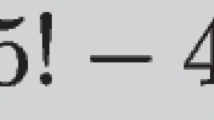Abstract
An uncovering-by-bases for a group G acting on a finite set Ω is a set \(\mathcal{U}\) of bases for G such that any r-subset of Ω is disjoint from at least one base in \(\mathcal{U}\), where r is a parameter dependent on G. They have applications in the decoding of permutation groups when used as error-correcting codes, and are closely related to covering designs. We give constructions for uncoverings-by-bases for many families of base-transitive group (i.e. groups which act transitively on their irredundant bases), including a general construction which works for any base-transitive group with base size 2, and some more specific constructions for other groups. In particular, those for the groups GL (3,q) and AGL (2,q) make use of the theory of finite fields. We also describe how the concept of uncovering-by-bases can be generalised to matroid theory, with only minor modifications, and give an example of this.
Similar content being viewed by others
References
Bailey RF (2006)Permutation groups, error-correcting codes and uncoverings. Ph.D. Thesis, University of London, 2006.
Bailey RF Error-correcting codes from permutation groups, submitted to Discrete Math. Preprint available from http://www.maths.qmul.ac.uk/~∼ rfb/papers/
Bailey RF, Bray JN (In preparation) Decoding the Mathieu group M 12
Cameron PJ (1993) Some multiply transitive permutation groups. In: Jungnickel D, Vanstone SA (eds) Coding theory, design theory, group theory: proceedings of the Marshall Hall conference. Wiley, New York
Cameron PJ (1999) Permutation groups, London Mathematical Society Student Texts, Vol 45. Cambridge University Press, Cambridge
Cameron PJ, Deza M (1979) On permutation geometries. J Lond Math Soc 20(2):373–386
Cameron PJ, Fon-Der-Flaass DG (1995) Bases for permutation groups and matroids. Eur J Combinatorics 16:537–544
Carlitz L (1952) Primitive roots in a finite field. Transact Am Math Soc 73:373–382
Carlitz L (1952) Some problems involving primitive roots in a finite field. Proc Nat Acad Sci USA 38:314–318, 618
Cohen SD (1990) Primitive elements and polynomials with arbitrary trace. Discrete Math 83:1–7
Cohen SD, Huczynska S (2003) The primitive normal basis theorem—without a computer. J Lond Math Soc 67(2):41–56
Conway JH, Curtis RT, Norton SP, Parker RA, Wilson RA 1985 (reprinted with corrections, 2003) \(\mathbb{ATLAS}\) of Finite Groups. Clarendon Press, Oxford
Davenport H (1968,1969) Bases for finite fields. J Lond Math Soc 43:21–39; 44:378
Dixon JD, Mortimer B (1996) Permutation groups. Graduate Texts in Mathematics, Vol 163. Springer-Verlag, New York
The GAP Group (2004) GAP—Groups, algorithms, and programming, Version 4.4. (http://www.gap-system.org)
Gordon DM La Jolla Covering Repository, http://www.ccrwest.org/cover.html
Gordon DM, Kuperberg G, Patashnik O (1995) New constructions for covering designs. J Comb Des 3:269–284
Gorenstein D, Hughes DR (1961) Triply transitive groups in which only the identity fixes four letters. Illinois J Math 5:486–491
Jordan C (1873) Sur la limite de transitivité des groupes non-alternées. Bull Soc Math France 1:40–71
Lenstra Jr HW, Schoof RJ (1987) Primitive normal bases for finite fields. Math Comp 48:217–231
Lidl R, Niederreiter H (1997) Finite fields. Encyclopedia of Mathematics and its Applications (20), 2nd edn. Cambridge University Press, Cambridge
Maund T (1989) Bases for permutation groups. D.Phil. Thesis, University of Oxford
Mills WH (1979) Covering designs. I. Coverings by a small number of subsets. Ars Combin 8:199–315
Mills WH, Mullin RC (1992) Coverings and packings. In: Dinitz JH, Stinson DR (eds) Contemporary design theory: a collection of surveys. Wiley, New York
Neumann PM, Stoy GA, Thompson EC (1994) Groups and geometry. Oxford University Press, Oxford
Oxley JG (1992) Matroid theory. Oxford University Press, Oxford
Zassenhaus H (1936) Kennzeichnung endlicher linearer als Permutationsgruppen. Abh Math Sem Hamburg 11:17–40
Zassenhaus H (1936) Über endliche Fastkörper. Abh Math Sem Hamburg 11:187–220
Zil’ber B (1988) Finite homogeneous geometries. Seminarber Humboldt-Univ Berlin Sekt Math 98:186–208
Author information
Authors and Affiliations
Corresponding author
Additional information
Communicated by J. D. Key.
Rights and permissions
About this article
Cite this article
Bailey, R.F. Uncoverings-by-bases for base-transitive permutation groups. Des Codes Crypt 41, 153–176 (2006). https://doi.org/10.1007/s10623-006-9005-x
Received:
Revised:
Accepted:
Published:
Issue Date:
DOI: https://doi.org/10.1007/s10623-006-9005-x



